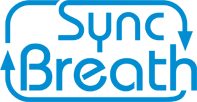3 part converted breathing
I use my limbs in pairs. I walk with my two legs or row with my two hands in a natural 2-beat rhythm (left, right, left, right). Therefore, using an even-beat rhythm while still maintaining 3-part breathing is more convenient and natural. The pacing is done in counts and can be timed using any of the methods mentioned earlier. i.e., a timer, beats of a metronome, or mantra-pacing.
Converting 3-part breathing into an even rhythm
2-step conversion of 3-part inhale
- Inhale and inflate my abdomen in 360o to maximum diaphragm amplitude – 1 count.
- Inhale further and sequentially inflate my ribcage in 360o, followed by inflating my chest – 1 count.
For a 2-step exhale, I perform the above steps in reverse order.
4-step conversion of 3-part inhale
I divide Step 1 into two separate steps. The first is inhaling to half diaphragm amplitude and the second is to inhale to full diaphragm amplitude.
- Inhale and inflate to half diaphragm amplitude – 1 count.
- Inhale further and inflate to full diaphragm amplitude – 1 count.
- Inhale further to inflate my ribcage in 360o – 1 count.
- Inhale further to inflate my chest – 1 count.
For a 4-step exhale, I perform the above steps in reverse order.
Visualizing 3-part breathing along the ‘Z’ path
Inflating my lungs in 2 steps and deflating in 4 steps along the inverted ‘Z’ path
To visualize inhaling as in 3-part breathing along the imaginary, inverted ‘Z’ path:
- I visualize the movement of my diaphragm starting at the center of the bottom line (the spine) of the inverted ‘Z’ and expanding like a flat disk in 360o until it reaches my navel.
- Next, I visualize the Air filling my ribcage, starting from my navel toward the rear part of my lower neck (along the diagonal of the inverted ‘Z’).
- Finally, I visualize the Air filling my chest, in a forward movement, from the rear part of my lower neck toward my collarbone (along the top horizontal line of the inverted ‘Z’).
The exhale can be traced in reverse along the same path—first comes the top horizontal line, then the diagonal, and finally, the bottom horizontal line. After my diaphragm constricts in 360o, it is represented on the diagram as a small flat disc.
This visualization guides me to inflate my chest forward along the top horizontal line and not upward toward my nose as I would instinctively. This way, I don’t trigger the ‘fight or flight’ state by filling the very top of my lungs first. In addition, activating my breathing muscles as per this visualization, helps me avoid activating my neck and shoulder muscles (secondary breathing muscles).
